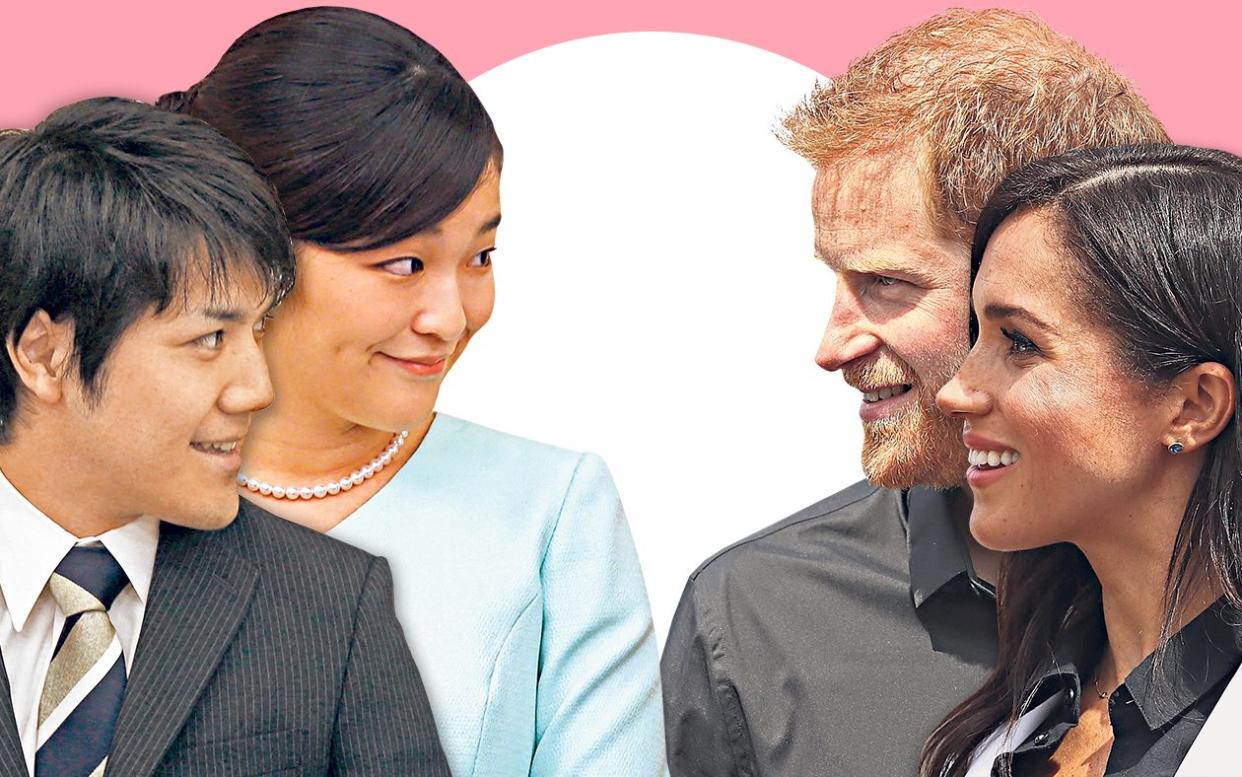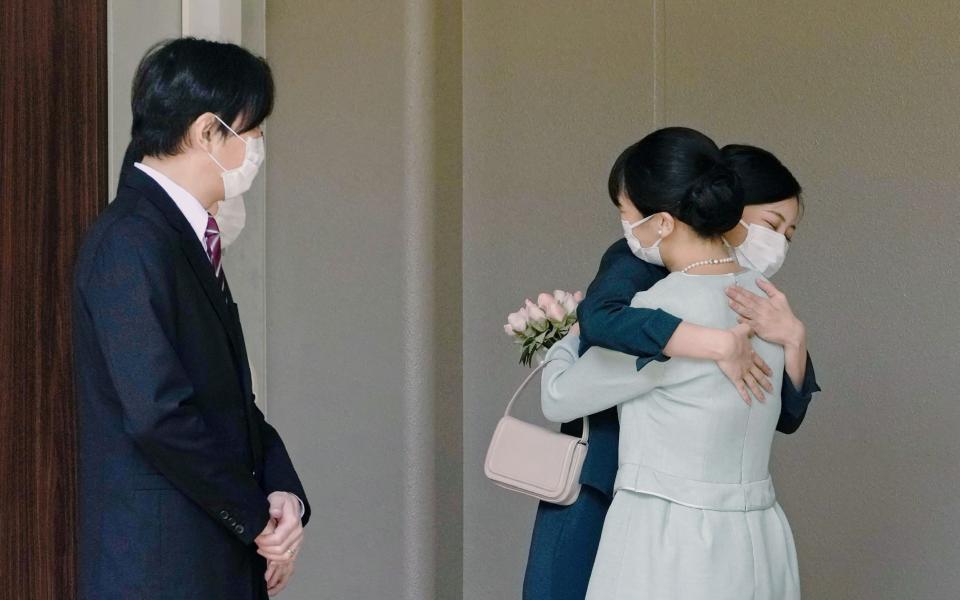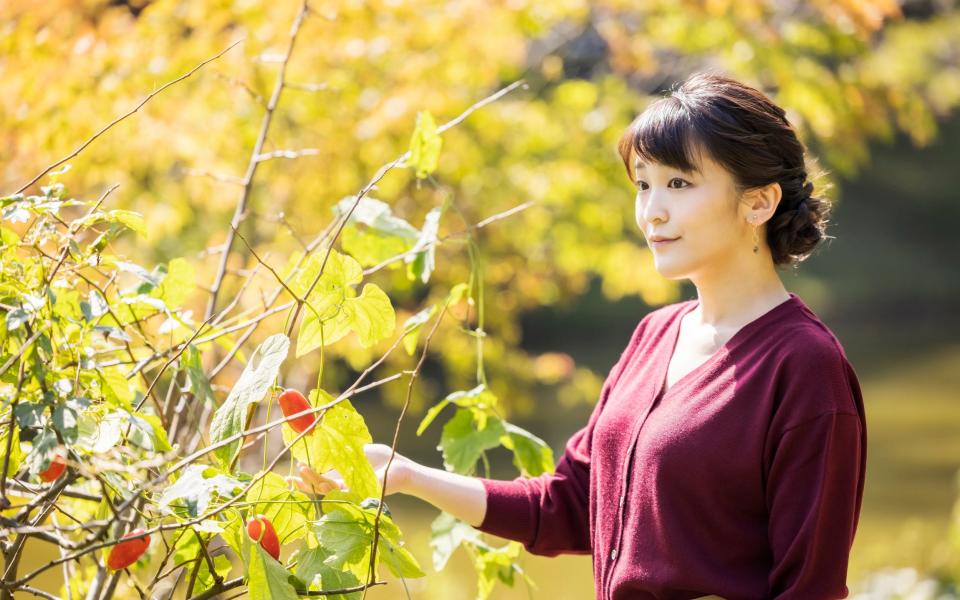Are Princess Mako and her new husband Japan’s answer to Harry and Meghan?

It’s perhaps the ultimate post-modern fairytale. A Japanese princess gets married – but there are no Shinto shrine blessings. No millennia-old Imperial rituals. No exquisitely layered bridal kimonos. No symbolic sips from a sake cup. No balcony kisses. No state banquets. And no visible signs of cheering crowds of well-wishers.
Instead, Japan’s Princess Mako, niece of the emperor, found her own alternative version of a happy ending this week, when she married her university boyfriend Kei Komuro in a low-key administrative event involving an official taking paperwork to the local registry office.
The pomp-free marriage marks the tense apex of a tumultuous four-year journey for the couple, both 30, who announced their engagement in September 2017 – initially to great national happiness, with an uproar only triggered when tabloid newspapers reported on a financial dispute relating to Komura’s mother.

Polite Japanese-style demonstrations against the marriage filled the streets of the upmarket Ginza shopping district in Tokyo, with many protesters appearing to be sedate middle-aged or elderly women, waving placards such as ‘Do not pollute Imperial Household with this cursed marriage!’.
But Princess Mako held firm, confident in her love for her “irreplaceable” beau despite a torrent of negative press coverage and social media critiques of everything from his mother’s finances to the “inappropriate” ponytail with which he was once photographed.
In Japan, it is convention for royal women to forgo their Imperial status upon marriage and become commoners, due to its strict male-only succession laws and a slimming down of the monarchy.

In the face of divided public opinion over her choice of husband, the former princess not only made a point of forgoing the traditional rituals-laden Imperial marriage ceremony to which she was entitled – she also made the extraordinary decision to become the first female member since the Second World War to turn down a payment of 152.5 million yen (nearly £1 million), traditionally given to women to preserve their dignity upon leaving the Imperial family. Their marriage paves the way for her to move to New York and start a new life.
It’s a narrative that might sound familiar, with some observers quick to draw comparisons between the Japanese couple and Meghan Markle and Prince Harry.
At first glance, the similarities are obvious. When the Duke and Duchess of Sussex dropped an Instagram bombshell in January 2020, outlining their decision to “step back” as senior Royals, it had been preceded by a similarly turbulent culmination of factors.
There was the intense media scrutiny around the Duchess and her family relations (simply swap ‘ponytail’ for ‘avocado toast’). Royalists looked on with dismay as the newlyweds hinted at their increasing disquiet among the Royal household and started the freedom-finding process that became known as Megxit; moving first to Canada and then to the US, where they live today. In a tell-all interview with Oprah Winfrey, Harry complained that his father “literally cut me off financially” after he stepped down as a senior Royal, while Meghan discussed how her time spent in the UK had a severe impact on her mental health. In the run up to Princess Mako’s wedding, it was announced that she had been diagnosed with a type of post-traumatic stress disorder as a result of the intense media scrutiny and critiques that the couple had faced.
Yet this week, the former princess appeared to distance herself from any potential comparisons during a press conference after her marriage was confirmed – as reflected in her response to a question asking how she felt about her “engagement becoming a big scandal in the media, including being compared to Meghan Markle” and whether she, like the Sussexes, would consider doing an TV interview with Oprah Winfrey.
“It is sad for me to receive this sort of question, which may give the impression that false information is fact,” she said. “We have never considered our engagement to be a scandal, though unfortunately there have been some disputes.
“As for the comparison, I don’t have any particular thoughts. I would like to refrain from answering questions about my future personal life. I am not considering giving any interviews at the moment. What I would like is just to lead a peaceful life in my new environment.”
It’s not just lip service. While the Sussexes have signed several high profile business deals, including a podcasting contract with Spotify and a multi-year deal with Netflix, observers believe that the US will offer Mr and Mrs Komuro, as they are now known, the peaceful life they crave.
For Mako, who obtained a master’s degree in art museum and gallery studies at University of Leicester, and also studied art history at the University of Edinburgh, this will most likely take the form of seeking work in New York’s art world. Meanwhile, her husband is due to start a new job as a freshly qualified lawyer at Lowenstein Sandler.
“Generally among people here in New York... almost no one is interested in them or pays attention to their controversial engagement,” Kasumi Abe, a Japanese journalist based in New York, told The Telegraph. “In the past three years, nobody knows about Kei Komuro in the US, and not so much of the US media has paid attention to him.”

British royals are “accustomed to making money and they know how to make it,” adds Professor Ken Ruoff, director of the Center for Japanese Studies at Portland State University and author of Japan’s Imperial House in the Postwar Era.
“Harry and Meghan very much demonstrated that when they came to the United States, whatever one thinks of the methods by which they did it. I can almost guarantee you that there is next to zero chance that Princess Mako and her husband will do anything along the lines of what Harry and Meghan did. What is going to happen is that they are going to drop out of public view.”
It’s also tough to reconcile the life Mako is turning her back on with that which dismayed Meghan and Harry so much. For Mako, the challenges have been more intense in some respects. The gender inequalities facing women across Japan have long been well documented (it came 120th among 156 countries in gender gap rankings earlier this year). And such pressures are undoubtedly amplified among female members of the Imperial family – perhaps little surprise bearing in mind the deeply-rooted respect that the nation still widely holds towards its royal family, with emperors regarded as divinities until as recently as 1946.
Every element of life among the Japanese monarchy – which is today purely ceremonial with no political powers – is famously choreographed and micro-managed by the Imperial Household Agency, which pretty much runs the lives of the family members.

The multi-layered, complex and often unspoken rules that underpin the fundamentals of Japanese society are also magnified within the Imperial household. Komuro’s middle-class upbringing was a source of amazement and criticism in the Japanese media. Tabloids suggested “commoner” Komuro was marrying into the family for money or fame. Paparazzi followed him to New York, where they mocked his habit of buying food from street vans. According to one magazine, a royal court official sneered at Komuro’s habit of wearing pinstripe suits, rather than the traditional black or navy.
Contrary to what British republicans might claim, snobbery was never a major factor in the public’s reaction to Meghan – although when Prince William announced his engagement in 2010, Kate Middleton’s middle-class upbringing was certainly a talking point. Palace officials were reported to have made snobbish remarks, particularly about the fact that Carole, Kate’s mother, used to work as an air hostess. But by 2017, when Prince Harry proposed to Meghan, the idea of a royal marrying a middle-class subject was no longer such a radical idea and it would have taken a cold heart not to feel moved by the romance and spectacle of their grand state wedding in Windsor Castle a year later.
It may have taken place in the dry setting of the Tokyo hotel conference room, but Princess Mako and her university sweetheart still managed to evoke a sense of romance, as they sat at a table before two slender black microphones during their first public appearance as husband and wife.
In an unusually open display of affection by royal Japanese standards, Komuro pledged to support and protect his wife, saying simply: “I love Mako. I want to spend the only life I have with the one I love.”
Mako added: “Kei is irreplaceable for me. For us, marriage is a necessary choice to live while cherishing our hearts.”
Additional reporting by Luke Mintz

